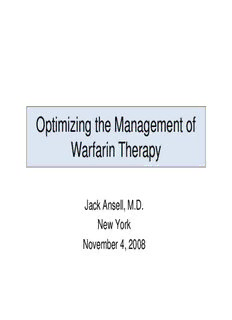
Optimizing the Management of Warfarin Therapy PDF
Preview Optimizing the Management of Warfarin Therapy
Optimizing the Management of Warfarin Therapy Jack Ansell, M.D. New York November 4, 2008 HHooww ccoouulldd tthhiiss ppaattiieenntt hhaavvee bbeeeenn mmaannaaggeedd bbeetttteerr .. .. .. A 71 year old male was started on warfarin for an embolic CVA related to atrial fibrillation. He was discharged after being switched from heparin to warfarin with an INR of 2.1 on the day of discharge. An INR 4 days later was 2.8. His next INR was ordered for 3 weeks later; he obtained the INR in the morning and went home waiting for the call. Later that day, at home, he was found comatose. The INR pending from the morning was 14.6. The patient was found to have a massive intracranial hemorrhage and he subsequently died. Even without knowing more information about this case, what went wrong? There are at least 2 management deficits, both of which could have been avoided. TThhee DDiilleemmmmaa ooff CCuurrrreenntt OOrraall AAnnttiiccooaagguullaanntt TThheerraappyy • Warfarin has a narrow therapeutic window of effectiveness and safety • Many factors influence a patient’s ability to stay in that window (diet, meds, illnesses) • Frequent monitoring is required to maintain patients in the therapeutic window • Monitoring is labor intensive, complex and may lead to under use of therapy • Warfarin has a high rate of adverse events in real world and may lead to under use of therapy AAnnttiiccooaagguullaattiioonn TThheerraappyy Impediments to Care Patient Related Travel to office, lab Wait to be seen Venipunctures Reports delayed Costs Physician Related Scheduling tests Reports delayed Contacting Patient Reimbursement Technology Related Sample handling Availability of result Accuracy, consistency GGooaallss ooff WWaarrffaarriinn TThheerraappyy To achieve the greatest reduction in thromboembolism with the lowest incidence of bleeding. This involves knowing: - When to use ((pprrooppeerr iinnddiiccaattiioonnss)) - How much to use ((pprrooppeerr tthheerraappeeuuttiicc rraannggee)) - How to use (proper dose management) WWaarrffaarriinn HHaass aa NNaarrrrooww TThheerraappeeuuttiicc WWiinnddooww Relationship Between Clinical Events and INR Intensity in Patients with Prosthetic Valves 100 80 60 Incidence / 100 patient - years 40 20 0 4 9 4 9 4 9 4 9 4 9 4 5 1. 1. 2. 2. 3. 3. 4. 4. 5. 5. 6. 6. 0- 5- 0- 5- 0- 5- 0- 5- 0- 5- 0- ≥≥≥≥ 1. 1. 2. 2. 3. 3. 4. 4. 5. 5. 6. INR Cannegeiter et al WWaarrffaarriinn HHaass aa NNaarrrrooww TThheerraappeeuuttiicc WWiinnddooww Relationship Between Clinical Events and INR Intensity in Patients with Atrial Fibrillation 1155 Ischemic Stroke Therapeutic ICH Window 1100 Odds Ratio 55 11 00 11 22 33 44 55 66 77 88 IINNRR 1. Hylek EM et al. Ann Intern Med. 1994;120:897. 2. Hylek EM et al. N Engl J Med. 1996;335:540. Intrinsic CCooaagguullaattiioonn CCaassccaaddee XII Vitamin K Dependent Factors XI Extrinsic Tissue Factor 24 hr IX 6 hr VIII VII X 36 hr aPTT PT / INR V 60 hr II I Fibrin Clot Prothrombin Precursor Prothrombin O O H H || H H || N-C-C N-C-C | | -Carboxy- Glutamic CH CH 2 2 Glutamic Acid | | CH2 CH Acid | / \ COOH HOOC COOH “Carboxylase” CO 2 O 2 CO 2 Reduced Vitamin K Oxidized Vitamin K VViittaammiinn KK OOxxiiddee RReedduuccttaassee CYP1A2 CCYYPP22CC99 n CYP3A4 ri S-w rf a arf w a ari R - n WARFARIN Adapted, B. Gage WWaarrffaarriinn ddoossiinngg eeqquuaattiioonn Exp[0.9751-0.3238 x VKOR3673G>A + 0.4317 x BSA – 0.4008 x CYP2C9*3 – 0.00745 x Age – 0.2066 x CYP2C9*2 + 0.2029 x Target INR – 0.2538 x Amiodarone + 0.0922 x Smokes – 0.0901 x African American race + 0.0664 x DVT/PE] The SNPs are coded 0 if absent, 1 if heterozygous, and 2 if homozygous and race is codes as 1 if African American and 0 otherwise B. Gage. www.warfarindosing.org
Description: